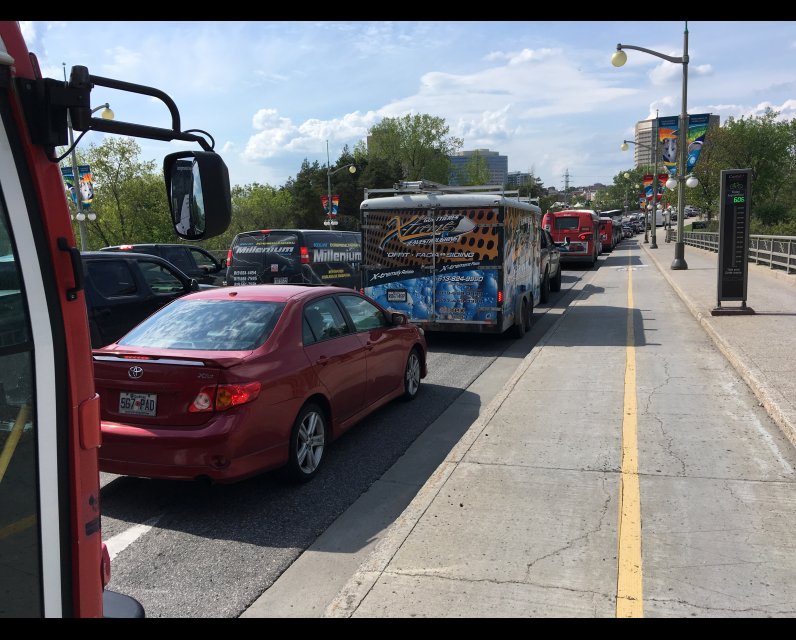Can cycling and the LRT mix? Indeed!

The Transit Commission voted overwhelmingly in favour for allowing bicycles on the LRT. The Commission voted down the option of a ban in peak hours (which is 50% of the time between 6 am and 6 pm) and instead would like to collect data first. Bike Ottawa believes this is the right thing to do. Now City council has to vote on this. This letter by Bike Ottawa board members Heather Shearer and Alex deVries was published by the Ottawa Citizen first. We added some sub headings for readability.
Will there be room for bikes on Ottawa’s new $2.1-billion LRT system?
At last Wednesday’s Transit Commission meeting, staff recommended that bikes be banned completely during peak periods, from 6 to 9 a.m. and 3 to 6 p.m. A number of the commission’s members were wondering why staff were suggesting we couldn’t get everyone on the train. It didn’t seem like the right move for a city that wants to be green and sustainable. Ultimately, the commission rejected the staff-recommended limits.
We were confused, too. It’s cost-effective if every train is jam-packed, standing-room-only. But that’s a terrible starting point for attracting new users. They expect a little personal space and a seat.
Impact on system away from rails
We’ve seen this before: Build something new, then maybe consider the cycling aspect after. It happened with the Booth Street Bridge in 2016 (also an LRT project). It was to have proper bike lanes, but they got removed from the plans. Interim lanes were forced in, so narrow that few cyclists would feel safe. Maybe the bridge will be reconfigured later.
Much attention has been given to shiny new stations and trains, but not much to the impact of the system away from the rails. Not everyone lives in a high-rise next to a station. Many live in suburbs some distance away from LRT. Not everybody works downtown. Access will be crucial for widespread adoption.
Cycling can be a game changer
OC Transpo would let you believe that we’ll take buses to stations, but these can be infrequent and slow on residential streets. That’s where cycling can be a be a game-changer: A short and direct cycling trip will be much faster than a meandering local bus.
This is going to be more of an issue as the LRT extends to areas with lower residential and employment density. Consider the Moodie station in Stage 2. It’s one kilometre from the new DND campus. Which would you prefer: a five-minute bike ride, a 10-minute walk, or waiting an indeterminate amount of time for the bus?
Bike shares in bikable cities
Bikeable cities have extensive bike share programs at major stations, so you can get off the train and hop right on a borrowed bike. For those who leave their own bike at the station, parking needs to be covered, under camera and dependable, so it gets used. All of this reduces demand for taking bikes on the train.
Flexibility is key. Bad weather in the morning? Take the bus. Or maybe it’s a nice afternoon and you just want to bike the whole way home, even if it is a little longer. Maybe you have a side errand to run during your travels where your bike is the perfect tool to zip out and back.
Apples to oranges
The chair of the Transit Commission argued that cities like Amsterdam and Copenhagen don’t let bikes on trains in rush hour, so why should we? But their subways were designed long ago, and both those cities are less than one-tenth of our size and have more bike-only trips. The same could be said of many of the cities cited in the report. The policy for our new LRT should not include apples-to-oranges comparisons to cities with older subway systems.
Cycling and transit are complementary
We’ve missed an opportunity to use data on how people already mix cycling and transit. The city doesn’t gather metrics on how many bikes there are on the O-Train or utilization of the Rack’n’Roll system, both which have been around for more than a decade. And there’s no way to project how busy trains will be. Let’s see what these traffic patterns are once the system is live.
Cycling and transit are complementary; together they can make a fast, efficient way to get around. When we have a system that’s compelling, it will be easier for some people to choose sustainable transportation and leave their cars at home.
Reassuring
It was reassuring to see Ottawa’s Transit Commission turn down the staff proposal to ban bicycles from LRT trains during rush hour. Let’s use bicycles to make the LRT the most user-friendly it can be.
Alex deVries and Heather Shearer are board members of Bike Ottawa.



Comments
Be the first to comment